CNN-LSTM to Predict and Investigate the Performance of a Thermal/Photovoltaic System Cooled by Nanofluid (Al2O3) in a Hot-Climate Location
Abstract
:1. Introduction
- (1)
- Numerically study the effect of cooling a PV/T system with alumina nanofluid (Al2O3) in Tabuk, Saudi Arabia.
- (2)
- Develop neural network algorithms using long short-term memory (LSTM), gradient recurrent unit (GRU), convolutional neural network (CNN), hybrid LSTM-GRU, and hybrid CNN-LSTM to train the numerical data and predict the PV/T performance.
- (3)
- Evaluate the developed models based on various metrics, including the coefficient of determination (R2), mean absolute percentage error (MAPE), the root mean square error (RMSE), and mean absolute error (MAE).
2. Methodology
2.1. PV/T System Modeling
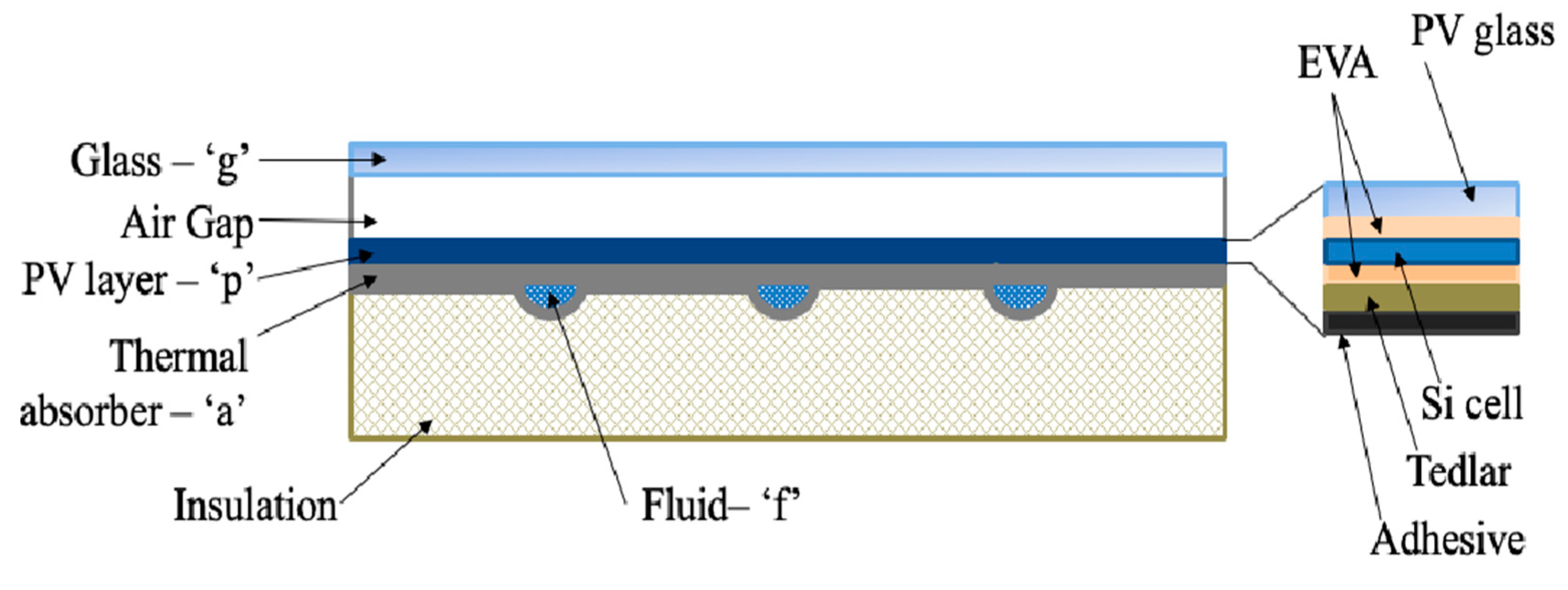
2.2. Predictive Models and Evaluations
2.2.1. Long Short-Term Memory (LSTM)
2.2.2. Gated Recurrent Unit (GRU)
2.2.3. Convolutional Neural Network (CNN)
2.2.4. Hybrid Neural Network (LSTM-GRU and CNN-LSTM)
2.2.5. Metric Evaluation
3. Results and Discussion
4. Conclusions
Funding
Data Availability Statement
Conflicts of Interest
Nomenclature
| Symbol | Description |
| Product of effective absorptivity and transmittivity | |
| Absorptivity of a cell | |
| Absorptivity of Tedlar | |
| Cell packing factor | |
| Specific heat capacity of the working fluid | |
| Working fluid mass flowrate | |
| Removal of thermal energy | |
| Ambient temperature | |
| PV/T back surface temperature | |
| PV/T cell temperature | |
| Transmissivity of glass | |
| Working fluid inlet temperature | |
| Working fluid outlet temperature | |
| Overall heat transfer coefficient from the cell to the atmosphere | |
| Overall heat transfer coefficient from the cell to Tedlar | |
| Overall heat transfer coefficient from glass to Tedlar through a solar cell | |
| Overall heat transfer coefficient from Tedlar to the working fluid |
References
- IEA. Buildings-Energy System; IEA: Paris, France, 2023; Available online: https://www.iea.org/energy-system/buildings (accessed on 15 July 2023).
- IEA. Saudi Arabia-Countries & Regions; IEA: Paris, France, 27 September 2020; Available online: https://www.iea.org/countries/saudi-arabia (accessed on 15 July 2023).
- Zito, B. Most Efficient Solar Panels of 2023 (Guide). Forbes. 4 July 2023. Available online: https://www.forbes.com/home-improvement/solar/most-efficient-solar-panels/ (accessed on 15 July 2023).
- Solar Performance and Efficiency. Energy.gov. (n.d.) Available online: https://www.energy.gov/eere/solar/solar-performance-and-efficiency (accessed on 15 July 2023).
- Wolf, M. Performance analysis of combined heating and photovoltaic power systems for residences. Energy Conversion. 1976, 16, 79–90. [Google Scholar] [CrossRef]
- Al-Waeli, A.H.A.; Sopian, K.; Kazem, H.A.; Chaichan, M.T. Photovoltaic/Thermal (PV/T) systems: Status and future prospects. Renew. Sustain. Energy Rev. 2017, 77, 109–130. [Google Scholar] [CrossRef]
- Al-Waeli, A.H.A.; Kazem, H.A.; Chaichan, M.T.; Sopian, K. Photovoltaic/Thermal System: Principles, Design and Applications, 1st ed.; Springer Nature: Berlin, Germany, 2020; ISBN 978-3-030-27824-3. [Google Scholar]
- Al-Waeli, A.H.A.; Chaichan, M.T.; Sopian, K.; Kazem, H.A. Influence of the base fluid on the thermo-physical properties of nanofluids with surfactant. Case Stud. Therm. Eng. 2019, 13, 100340. [Google Scholar] [CrossRef]
- Chen, J.F.; Zhang, L.; Dai, Y.J. Performance analysis and multi-objective optimization of a hybrid photovoltaic/thermal collector for domestic hot water application. Energy 2018, 143, 500–516. [Google Scholar] [CrossRef]
- Tang, X.; Quan, Z.; Zhao, Y. Experimental investigation of solar panel cooling by a novel micro heat pipe array. Energy Power Eng. 2010, 2, 171–174. [Google Scholar] [CrossRef]
- Mazón-Hernández, R.; García-Cascales, J.R.; Vera-García, F.; Kaiser, A.S.; Zamora, B. Improving the Electrical Parameters of a Photovoltaic Panel by Means of an Induced or Forced Air Stream. Int. J. Photoenergy 2013, 2013, 830968. [Google Scholar] [CrossRef]
- Khanjari, Y.; Pourfayaz, F.; Kasaeian, A. Numerical investigation on using of nanofluid in a water-cooled photovoltaic thermal system. Energy Convers. Manag. 2016, 122, 263–278. [Google Scholar] [CrossRef]
- Manigandan, S.; Kumar, V. Comparative study to use nanofluid ZnO and CuO with phase change material in photovoltaic thermal system. Int. J. Energy Res. 2019, 43, 1882–1891. [Google Scholar] [CrossRef]
- Al-Waeli, A.H.A.; Sopian, K.; Chaichan, M.T.; Kazem, H.A.; Hasan, H.A.; AlShamani, A.N. An experimental investigation of SiC nanofluid as a base-fluid for a photovoltaic thermal PV/T system. Energy Convers. Manag. 2017, 142, 547–558. [Google Scholar] [CrossRef]
- Nada, S.A.; El-Nagar, D.H.; Hussein, H.M.S. Improving the thermal regulation and efficiency enhancement of PCM-Integrated PV modules using nano particles. Energy Convers. Manag. 2018, 166, 735–743. [Google Scholar] [CrossRef]
- Al-Waeli, A.H.A.; Sopian, K.; Yousif, J.H.; Kazem, H.A.; Boland, J.; Chaichan, M.T. Artificial neural network modeling and analysis of photovoltaic/thermal system based on the experimental study. Energy Convers. Manag. 2019, 186, 368–379. [Google Scholar] [CrossRef]
- Yousif, J.H.; Kazem, H.A. Prediction and evaluation of photovoltaicthermal energy systems production using artificial neural network and experimental dataset. Case Stud. Therm. Eng. 2021, 27, 101297. [Google Scholar] [CrossRef]
- Al-Waeli, A.H.; Kazem, H.A.; Yousif, J.H.; Chaichan, M.T.; Sopian, K. Mathematical and Neural Network Models for Predicting the Electrical Performance of a PV/T system. Int. J. Energy Res. 2019, 43, 8100–8117. [Google Scholar] [CrossRef]
- Shahsavar, A.; Moayedi, H.; Al-Waeli, A.H.A.; Sopian, K.; Chelvanathan, P. Machine learning predictive models for optimal design of building-integrated photovoltaic-thermal collectors. Int. J. Energy Res. 2020, 44, 5675–5695. [Google Scholar] [CrossRef]
- Jakhar, S.; Paliwal, M.K.; Kumar, M. Machine learning predictive models for optimal design of photovoltaic/thermal collector with nanofluids based geothermal cooling. Environ. Prog. Sustain. Energy 2023, 42, e14131. [Google Scholar] [CrossRef]
- Diwania, S.; Kumar, M.; Kumar, R.; Kumar, A.; Gupta, V.; Khetrapal, P. Machine learning-based thermo-electrical performance improvement of nanofluid-cooled photovoltaic–thermal system. Energy Environ. 2022, 0958305X221146947. [Google Scholar] [CrossRef]
- Margoum, S.; Hajji, B.; El Fouas, C.; El Manssouri, O.; Aneli, S.; Gagliano, A.; Mannino, G.; Tina, G.M. Prediction of Electrical Power of Ag/Water-Based PVT System Using K-NN Machine Learning Technique. In Digital Technologies and Applications; Springer Nature: Cham, Switzerland, 2023; pp. 125–132. [Google Scholar] [CrossRef]
- Joshi, A.S.; Tiwari, A.; Tiwari, G.N.; Dincer, I.; Reddy, B.V. Performance evaluation of a hybrid photovoltaic thermal (PV/T) (glass-to-glass) system. Int. J. Therm. Sci. 2009, 48, 154–164. [Google Scholar] [CrossRef]
- Hedayatizadeh, M.; Ajabshirchi, Y.; Sarhaddi, F.; Safavinejad, A.; Farahat, S.; Chaji, H. Thermal and electrical assessment of an integrated solar photovoltaic thermal (PV/T) water collector equipped with a compound parabolic concentrator (CPC). Int. J. Green Energy 2013, 10, 494–522. [Google Scholar] [CrossRef]
- Gakkhar, N.; Soni, M.K.; Jakhar, S. Experimental investigation of exergy performance of a water cooled hybrid photovoltaic thermal collector. Int. J. Exergy 2020, 31, 330–351. [Google Scholar] [CrossRef]
- Dubey, S.; Tiwari, G.N. Thermal modeling of a combined system of photovoltaic thermal (PV/T) solar water heater. Sol. Energy 2008, 82, 602–612. [Google Scholar] [CrossRef]
- Duffie, J.A.; Beckman, W.A. Solar Engineering of Thermal Processes; John Wiley & Sons: Hoboken, NJ, USA, 2013. [Google Scholar]
- Jakhar, S.; Soni, M.S.; Gakkhar, N. Exergy analysis of a photovoltaic thermal system with earth water heat exchanger cooling system based on experimental data. Int. J. Exergy 2017, 23, 367–387. [Google Scholar] [CrossRef]
- Evans, D.L. Simplified method for predicting photovoltaic array output. Sol. Energy 1981, 27, 555–560. [Google Scholar] [CrossRef]
- Schott, T. Operation temperatures of PV modules-a theoretical and experimental approach. In Proceedings of the Sixth EC Photovoltaic Solar Energy Conference, London, UK, 15–19 April 1985; Inderscience: Geneve, Switzerland, 1985; pp. 1101–1110. [Google Scholar] [CrossRef]
- Hissouf, M.; Feddaoui, M.; Najim, M.; Charef, A. Numerical study of a covered Photovoltaic-Thermal Collector (PVT) enhancement using nanofluids. Sol. Energy 2020, 199, 115–127. [Google Scholar] [CrossRef]
- Kallio, S.; Siroux, M. Energy Analysis and Exergy Optimization of Photovoltaic-Thermal Collector. Energies 2020, 13, 5106. [Google Scholar] [CrossRef]
- Mushabbab, A. (University of Dayton, Dayton, OH, USA). Personal communication. 2023. [Google Scholar]
- Visual Crossing Corporation. Visual Crossing Weather (2018–2019). [Data Service]. 2020. Available online: https://www.visualcrossing.com/ (accessed on 1 June 2023).
- “Pvlib Python.” Pvlib Python-Pvlib Python 0.10.1 Documentation. Available online: https://pvlib-python.readthedocs.io/en/stable/ (accessed on 1 September 2023).
- RStudio Team. RStudio: Integrated Development for R; RStudio, PBC: Boston, MA, USA, 2020; Available online: http://www.rstudio.com/ (accessed on 1 June 2023).
- Alhamayani, A.D.; Sun, Q.; Hallinan, K.P. Estimating Smart Wi-Fi Thermostat-Enabled Thermal Comfort Control Savings for Any Residence. Clean Technol. 2021, 3, 743–760. [Google Scholar] [CrossRef]
- Alhamayani, A.D.; Sun, Q.; Hallinan, K.P. An Improved Method to Estimate Savings from Thermal Comfort Control in Residences from Smart Wi-Fi Thermostat Data. Clean Technol. 2022, 4, 395–406. [Google Scholar] [CrossRef]
- GERON, A. Hands-on Machine Learning with Scikit-Learn, Keras, and Tensorflow: Concepts, Tools and Techniques to Build Intelligent Systems; O’Reilly: Sebastopol, CA, USA, 2019. [Google Scholar]
- Hochreiter, S.; Schmidhuber, J. Long short-term memory. Neural Comput. 1997, 9, 1735–1780. [Google Scholar] [CrossRef]
- Chung, J.; Gulcehre, C.; Cho, K.H.; Bengio, Y. Empirical Evaluation of Gated Recurrent Neural Networks on Sequence Modeling. arXiv 2014, arXiv:1412.3555. [Google Scholar]
- Aksan, F.; Li, Y.; Suresh, V.; Janik, P. CNN-LSTM vs. LSTM-CNN to Predict Power Flow Direction: A Case Study of the High-Voltage Subnet of Northeast Germany. Sensors 2023, 23, 901. [Google Scholar] [CrossRef]
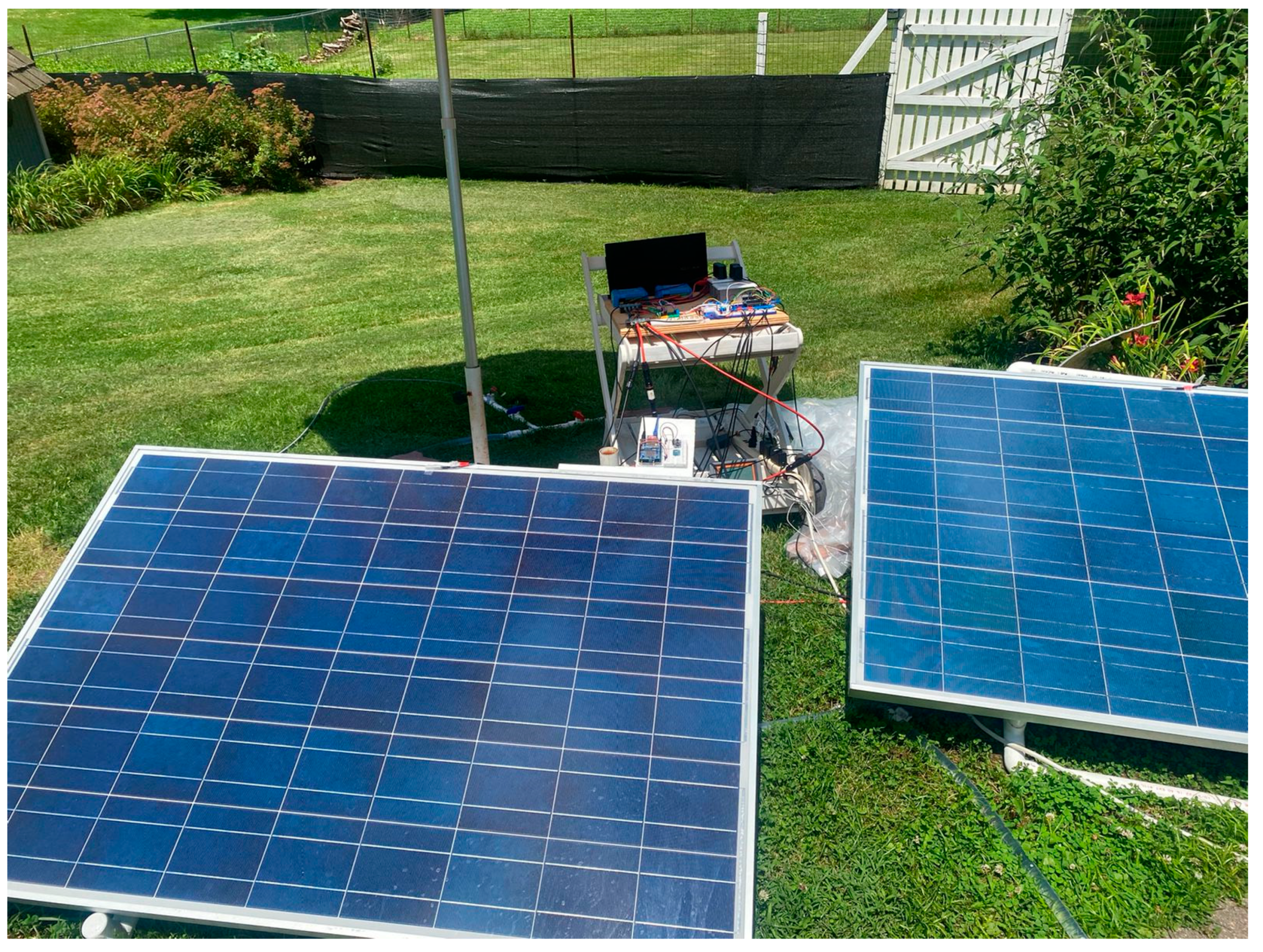

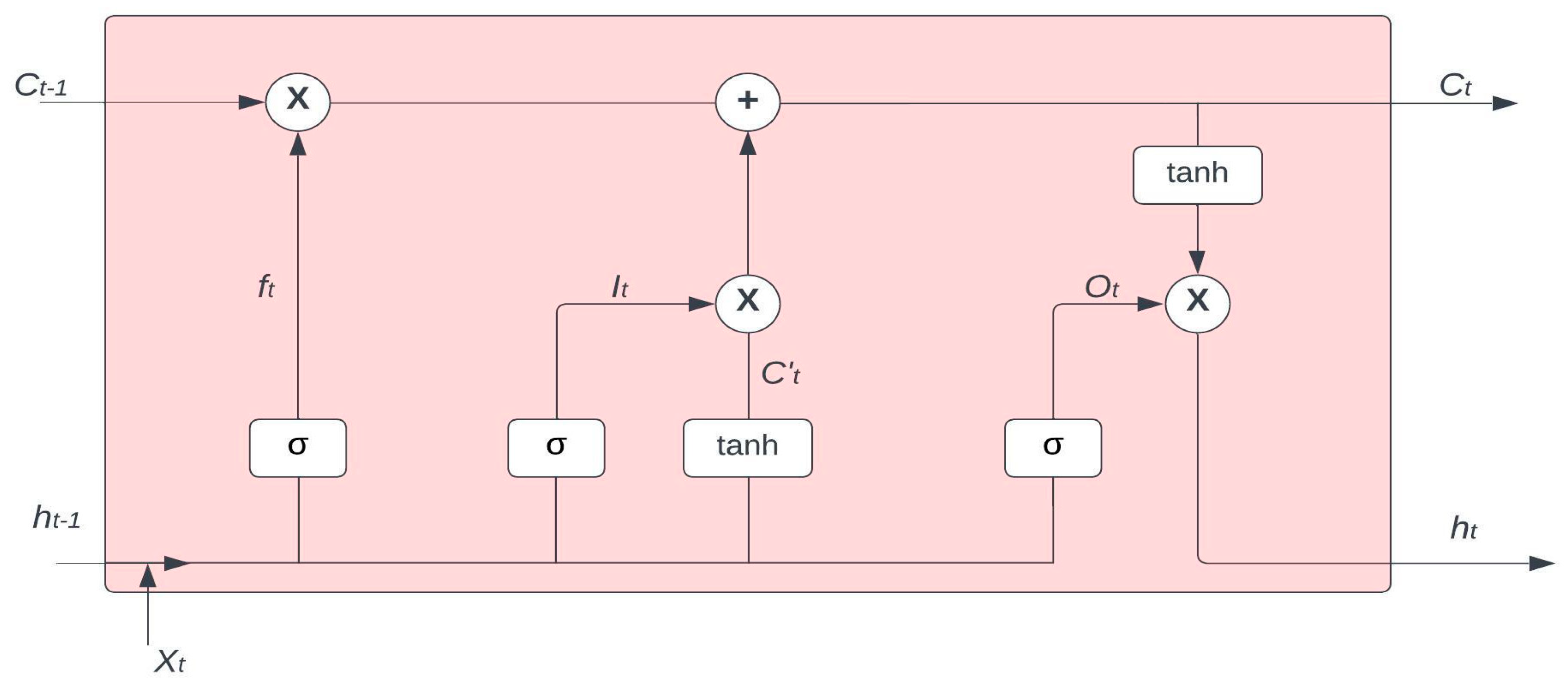



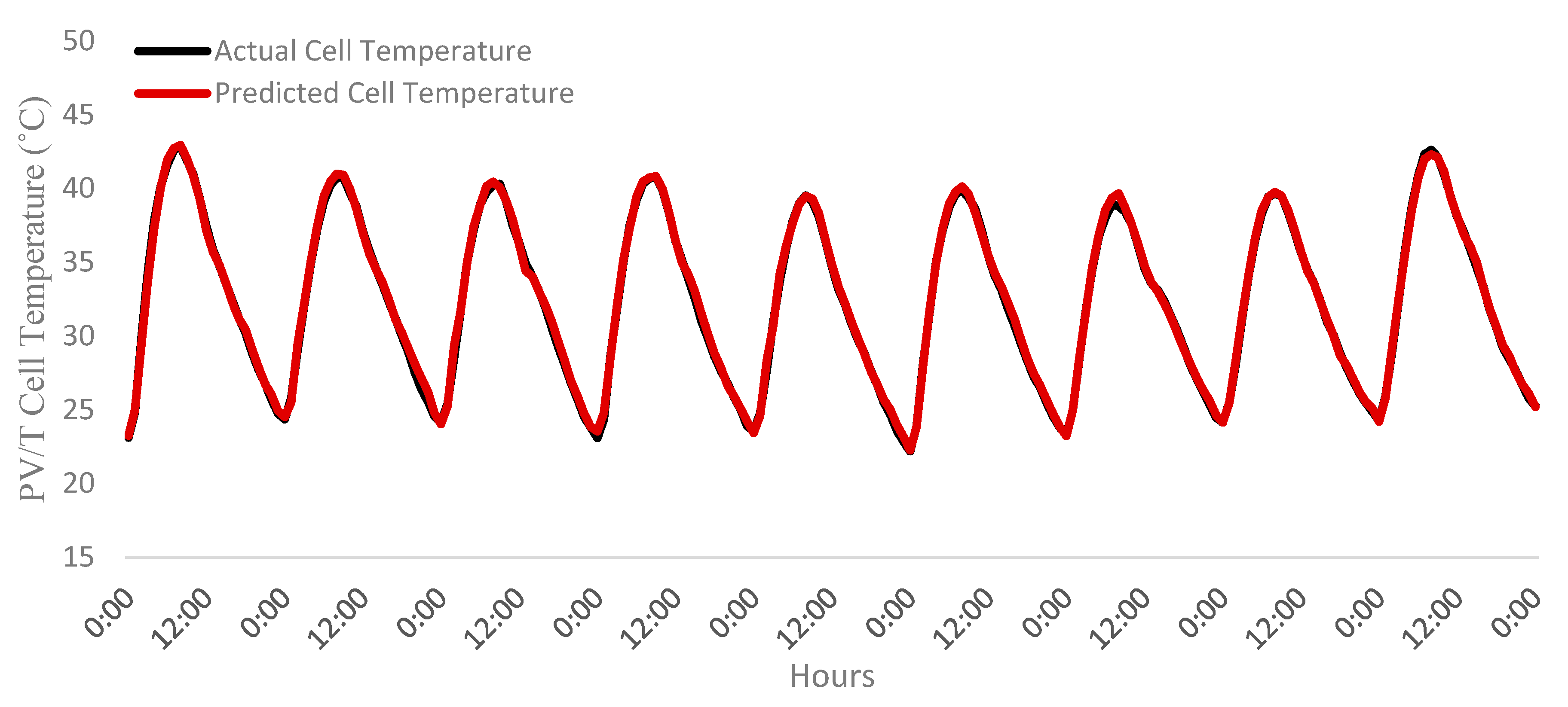
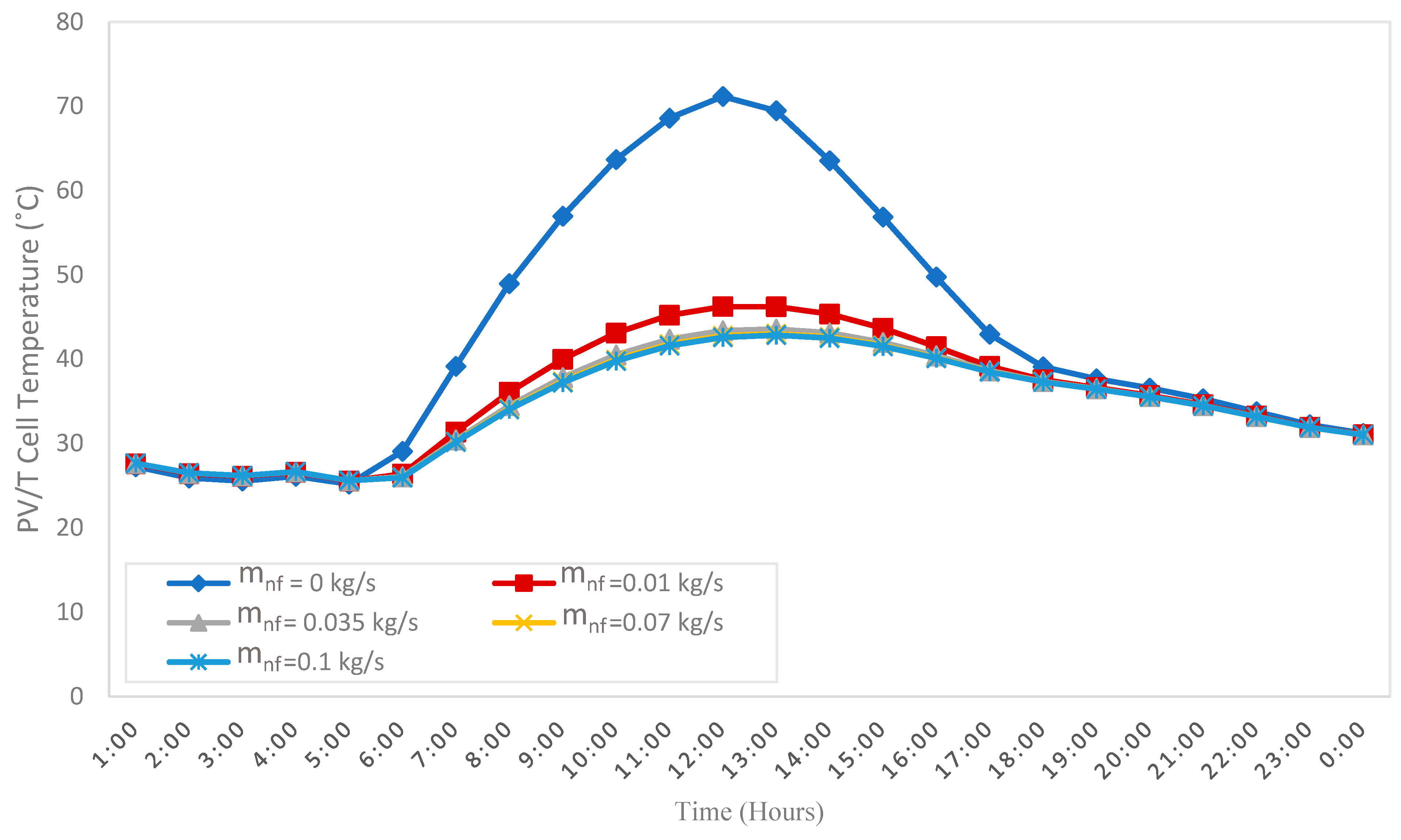
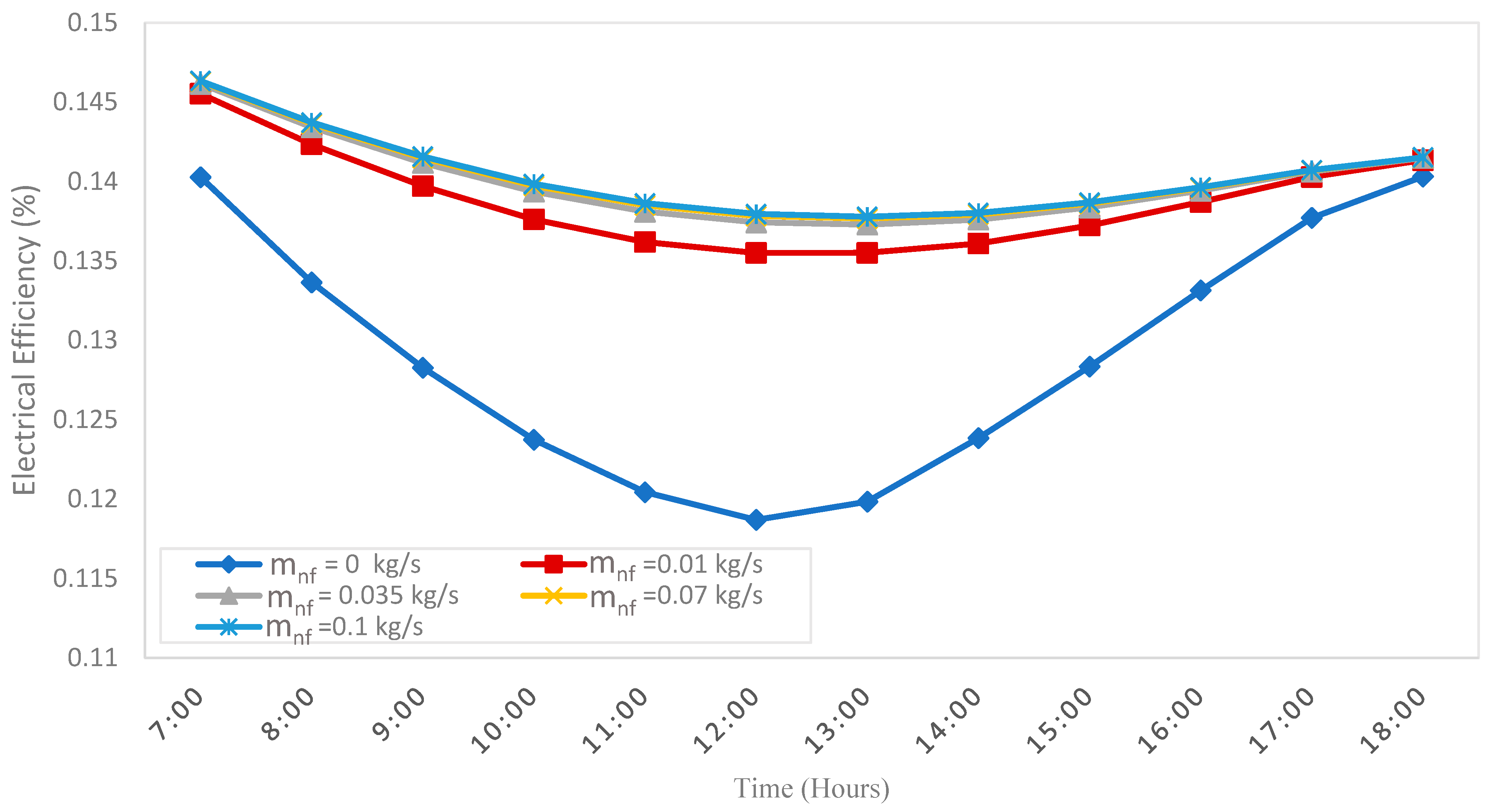
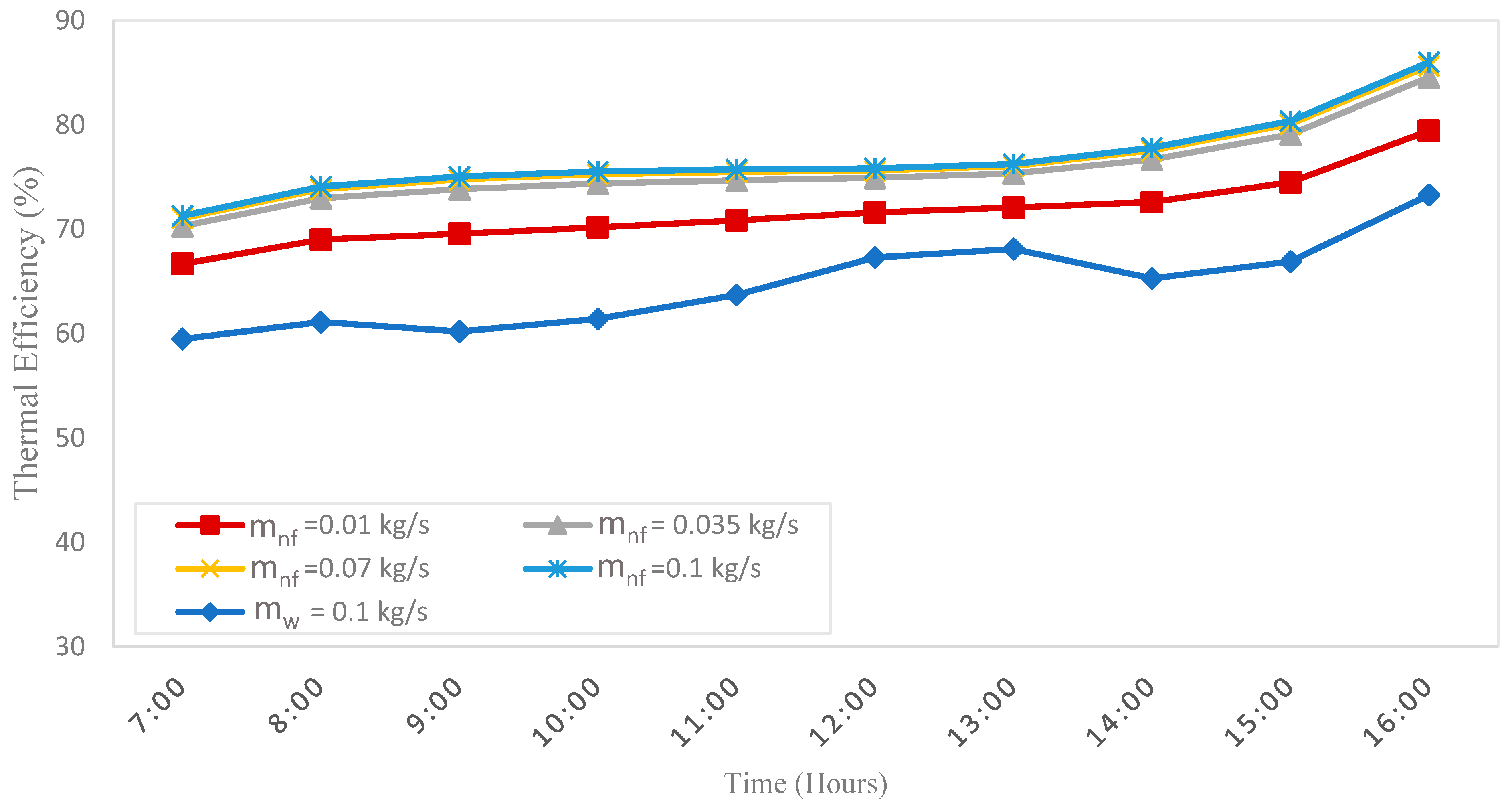

| Parameter | Value |
|---|---|
| PV glass’s transmissivity ( | 0.95 |
| PV glass cover’s thickness (tg) | 0.0032 m |
| PV glass cover’s thermal conductivity (kg) | 1 W/mk |
| PV cell’s absorptivity ( | 0.9 |
| PV cell’s transmissivity | 0.9 |
| PV cell thermal conductivity (kc) | 0.036 W/mk |
| Tedlar’s absorptivity ( | 0.75 |
| Absorber plate’s thermal conductivity | 385 W/m.k |
| Absorber plate’s thickness | 0.002 m |
| Packing factor of solar cell ( | 0.83 |
| Temperature coefficient of PV panel () | 0.0034 |
| Thermal conductivity of the epoxy adhesive | 1.04 W/m.k |
| Base fluid density (ρfb) | 998.2 Kg/m3 |
| Nanoparticle density (ρnp) | 3970 Kg/m3 |
| Base fluid thermal conductivity (kfb) | 0.6 W/m.k |
| Nanoparticle thermal conductivity (knp) | 40 W/m.k |
| Base fluid specific heat capacity (Cfb) | 4.182 kJ/kg.k |
| Nanoparticle specific heat capacity (Cnp) | 0.765 kJ/kg.k |
| Nanofluid volume fraction () | 5% |
| Structure of Layer | ||||||
|---|---|---|---|---|---|---|
| Model | 1st Layer | 2nd Layer | 3rd Layer | 4th Layer | 5th Layer | |
| LSTM | LSTM (N: 25/A: tanh) | dense (N:1/A: relu) | - | - | - | |
| GRU | GRU (N: 25/A: tanh) | dense (N: 1/A: relu) | - | - | - | |
| CNN | CNN (F: 30/Fz: 5/A: relu) | max pooling (Pz: 4) | flatten | dense (N: 1/A: sigmoid) | - | |
| LSTM-GRU | LSTM (N:25/A: tanh) | GRU (N: 15/A: tanh) | dense (N: 1/A:relu) | - | - | |
| CNN-LSTM | CNN (F: 64/Fz: 5/A: relu) | max pooling (Pz: 4) | flatten | LSTM (N: 25/A: tanh) | dense (N: 1/A: sigmoid) | |
| Hyperparameters | ||||||
| All models | Lookback Steps = 12 | Batch Size = 128 | ||||
| Model | MAPE (%) | RSME | MAE | |
|---|---|---|---|---|
| LSTM | 0.1456 | 0.6941 | 0.4349 | 0.991 |
| GRU | 0.1376 | 0.7194 | 0.4104 | 0.991 |
| CNN | 0.2178 | 1.0237 | 0.6483 | 0.983 |
| LSTM-GRU | 0.1280 | 0.6544 | 0.3815 | 0.992 |
| CNN-LSTM | 0.1260 | 0.6220 | 0.3750 | 0.993 |
Disclaimer/Publisher’s Note: The statements, opinions and data contained in all publications are solely those of the individual author(s) and contributor(s) and not of MDPI and/or the editor(s). MDPI and/or the editor(s) disclaim responsibility for any injury to people or property resulting from any ideas, methods, instructions or products referred to in the content. |
© 2023 by the author. Licensee MDPI, Basel, Switzerland. This article is an open access article distributed under the terms and conditions of the Creative Commons Attribution (CC BY) license (https://creativecommons.org/licenses/by/4.0/).
Share and Cite
Alhamayani, A. CNN-LSTM to Predict and Investigate the Performance of a Thermal/Photovoltaic System Cooled by Nanofluid (Al2O3) in a Hot-Climate Location. Processes 2023, 11, 2731. https://doi.org/10.3390/pr11092731
Alhamayani A. CNN-LSTM to Predict and Investigate the Performance of a Thermal/Photovoltaic System Cooled by Nanofluid (Al2O3) in a Hot-Climate Location. Processes. 2023; 11(9):2731. https://doi.org/10.3390/pr11092731
Chicago/Turabian StyleAlhamayani, Abdulelah. 2023. "CNN-LSTM to Predict and Investigate the Performance of a Thermal/Photovoltaic System Cooled by Nanofluid (Al2O3) in a Hot-Climate Location" Processes 11, no. 9: 2731. https://doi.org/10.3390/pr11092731






